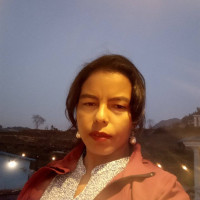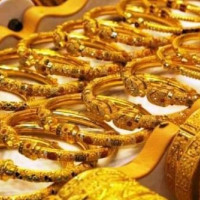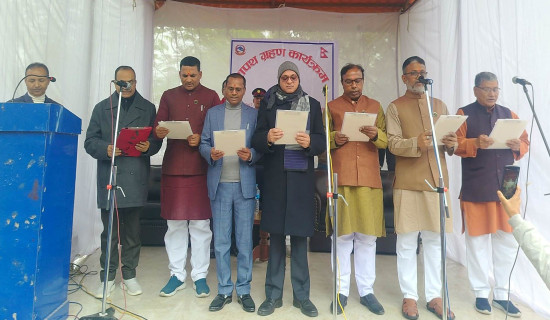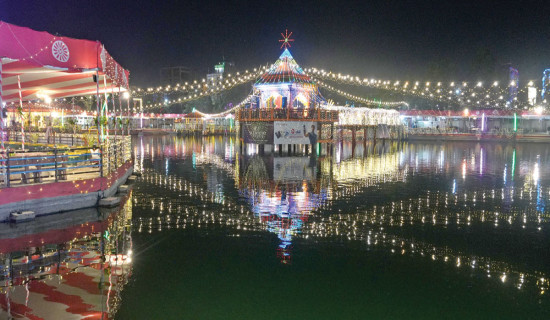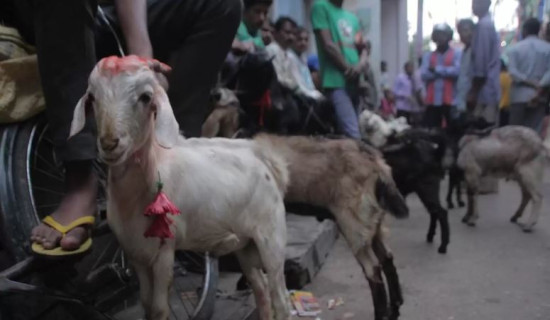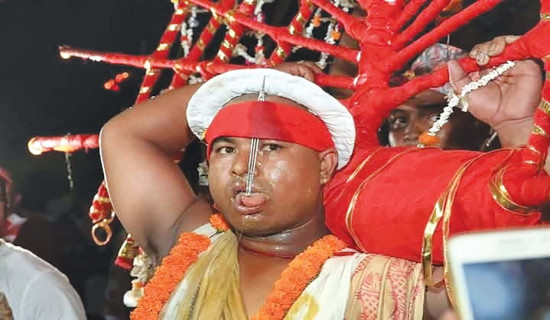- Wednesday, 31 December 2025
Septuagenarians performing Nilbarahi dance of Bode
Kathmandu, Aug. 22: Bode, the ancient town of Madhyapur Thimi Municipality in Bhaktapur district, is widely known for its tongue-piercing festival. It is also a place where traditional Nilbarahi dance is performed every year. However, the dance with rich historical and cultural values has been under shadow.
Nilbarahi Dana Naach or Nilbarahi Dyo Pyakhan is one of the ancient dances which has been in practice for over 500 years. The dance that constitutes different gods and goddesses is performed every year in Bode. It is performed for four nights and three days from Bhadra Ditiya to Panchami. Performed using a tantric approach, the dance involves 19 deities, including Bhairav, Barahi, Kumai, Simha, Dwarpal and Ganesh.
Various gurus, traditional musicians and others play key roles in organising the annual event.
It is said that the dance was started by King Subarna Malla in 1511 AD (Nepal Sambat 631). It used to be performed by the members of the Tha Shrestha community of Bode. However, over the four decades, it has been performed by the Aduwa Shrestha community of Lachhi Tole of Bode. Earlier, it used to be performed by another Shrestha community of Bode.
This year, the historic Nilbarahi Dance of Bode began on Wednesday and it will continue till Saturday.
Prem Chandra Aduwa Shrestha is the main Nilbarahi dancer. At the age of 73, he is going to dance for the record 66th time this year.
Including the main dancer, seven other septuagenarian dancers are also going to dance for the 66th time this year.
Sun Krishna Jayna is going to dance at the age of 75. Likewise, Ram Krishna Bhasika,75, Ganesha Bahadur Mastra, 78, and Kumar Aduwa, 72, are other dancers.
Nineteen Devgans are associated with the Nilbarahi Dance. Of them, one performs as Bhairav, four as Nilbarahi, four as Kumari, four as Simha, four as Ganesh and two as Dwarpals.
The dance begins and ends at Akha, the sacred spot in Lachhi near the Bode Narayan Temple. The dancers go around several religious shrines located in Lachhi Tole, Bishnughat Tole, Bhagu Tole, Khasi Tole and the Layaku area.
The performers of the tantric dance are called Devgans (God’s people). Eight of the 19 Devgans are now in their late 70s, and have to dance even in old age. They should take part in the dance performance until they die, he said.
Dances like these provide identity to Bode and make Madhyapur Thimi a living museum. The dance is performed and managed through the Guthi system, he said. “The dance is performed the whole night. All the Devgans march all the alleys of Bode town wearing traditional dress and a heavy mask. The alleys and junctions of the small ancient town fill with the crowd of devotees to offer worship to all the Devgans after they come out in the street dancing,” he said.
He further said, “It is difficult to perform the dance and is delayed to conclude it due to the crowd of people. Sometimes, it takes 12 hours to 18 hours to conclude it.”
“There are restrictions regarding the foods, postures and the people they could meet. They also have to dance barefoot around the alleys of Bode even if it is raining. Their steps have to match the beat of the music and some dances can last for up to 15 hours,” Shrestha said, calling these the key factors for failing to lure the new generation to the dance.
As a result, it is getting increasingly harder to find dancers because the family members of the Devgans have to follow strict rules like Devgans. “Recently, some of the Devgans passed away and we had to struggle a lot to find people willing to take their place. We need to do something to attract people,” he said.


